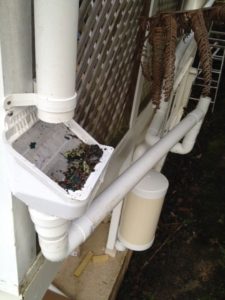 A pre-filter is designed to handle large amounts of debris that is more than a millimetre or two in size, and separate this material from your incoming water.
A pre-filter is designed to handle large amounts of debris that is more than a millimetre or two in size, and separate this material from your incoming water.
Pre-filters are not complex, expensive, or undeveloped, and are essential to filtration systems – so think carefully, some extra investment might be worth it!
The most important thing is that your pre-filter is easy to maintain, as it will handle the majority of the junk heading towards your system.
Common methods involve simple mesh screens (pictured), or various kinds of buckets filled with mesh or other material that can be easily emptied once filled with leaves or other debris.
Materials such as Hessian, old cotton, or old stockings can easily serve as an effective screen.
‘First flush’ filters
When collecting rainwater from a large area such as a roof, you should consider adding a “first flush” filter, sometimes called a first flush diverter.
These are designed to catch the first wave of incoming water, pollution and debris when it begins raining, fill up with water, then rout the overflow to your filter system.
A design that incorporates many first-flush filter elements:
Swirl filters
Swirl filters use gravity and design to separate solids from your water, without using a mesh or other filter medium. Incoming water is directed around the outer circumference of a round barrel or bucket, creating a swirling motion. solids swirl until they move towards the center of the container where the current is weaker, then sink to the bottom.
A small, simple swirl filter with an easy clean function integrated:
Learn More >>
Rainwater tank system overview @ FlyingNerd.com
Do it Yourself >>
Cheap swirl filter @ Youtube
Dirty rainwater tank solutions @ Rainline.co.nz
